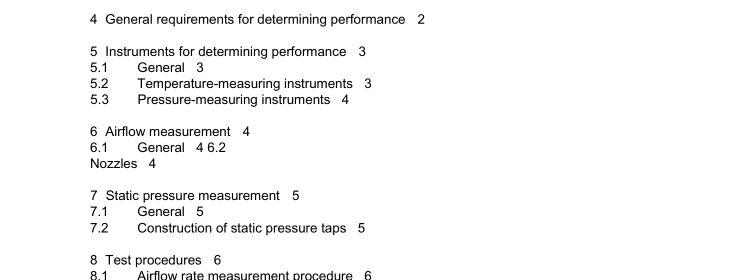CSA C439-09 pdf download – Standard laboratory methods of test for rating the performance of heat/energy-recovery ventilators.
5 Instruments for determining performance Note: See also Clause 6. 5.1 General The instruments used to determine performance shall be calibrated and traceable to a National Standard. 5.2 Temperature-measuring instruments 5.2.1 Except as specified in Clauses 5.2.2 to 5.2.6, temperature measurements and temperature-measuring instruments shall meet the requirements of ASHRAE 41.1. 5.2.2 Temperature measurements shall be made with one or more of the following instruments: (a) mercury-in-glass thermometers; (b) thermocouples; and (c) electric-resistance thermometers. 5.2.3 For air wet-bulb and dry-bulb temperatures the accuracy shall be ±0 .5 °C. Note: Wet-bulb temperatures should be read only under conditions that ensure an air velocity of 3.5 to 10 .0 m/s over the wet bulb (preferably close to 5.0 m/s), and only after time has been allowed for evaporative equilibrium to be attained. For wet-bulb determinations at temperatures below freezing, a recommended method is to freeze a coating of ice approximately 0 .5 mm thick directly on the bulb of the thermometer or other temperature-sensing element. Another method is to preheat an air sample before temperature measurement to raise the wet-bulb temperature above 0 °C. The preheat temperature should be as low as possible to minimize the wet-bulb depression. When an air sample is preheated, a dry-bulb temperature measurement should be taken upstream of the heater and the dry-bulb and wet-bulb temperatures read at the same station after preheating. Humidity may also be determined through a direct measurement of dew point using basic apparatus providing an accuracy of ±0 .4 °C.
6 Airflow measurement 6.1 General 6.1.1 Airflow rates at the four measurement stations (see Figure 1) may be determined using one of the following methods, provided that the cumulative accuracy of the instrumentation permits measurements within 5% of the actual flow rate or 5 L/s, whichever is smaller: (a) venturi tube; (b) flow nozzles; (c) averaging Pitot tubes; (d) laminar flow element; or (e) orifice plate. 6.1.2 The accuracy of the instrumentation shall be determined by measurements performed in accordance with ANSI/AMCA 210. 6.2 Nozzles Note: As shown in Figure 2, a nozzle station consists of a receiving chamber and a discharge chamber separated by a partition in which one or more nozzles (which can be of equal or unequal size) are located. 6.2.1 Each nozzle station shall have one or more diffusers, installed as follows: (a) in the receiving chamber, diffusers whose diameter is at least 1- 1/2 times larger than the diameter of the largest nozzle throat upstream of the partition wall; and (b) in the discharge chamber, diffusers whose diameter is at least 2-1/2 times larger than the diameter of the largest nozzle throat downstream of the partition wall. Screen diffusers shall meet the requirements of ANSI/AMCA 210. 6.2.2 The centre-to-centre distance between nozzles shall be at least three times the throat diameter of the largest nozzle. The distance from the centre of a nozzle to the nearest discharge or receiving chamber side wall shall be at least 1- 1/2 times its throat diameter.
6.2.3 Means shall be provided to determine the air density at the nozzle throat. Note: If freezing conditions exist, see Section 6.22 of ASHRAE 41.1. 6.2.4 The velocity at the nozzle throat shall be not less than 15 m/s and not more than 35 m/s. 6.2.5 When nozzles are constructed in accordance with Figure 3, and installed in accordance with Clause 6.2, they may be used without calibration. If the throat diameter is 120 mm or larger, the default coefficient of discharge shall be 0.99. For nozzles with a throat diameter smaller than 120 mm, or when a more precise coefficient is desired, the following procedure shall be used: (a) The temperature shall be measured and the corresponding temperature factor, f, selected from Table 1. (b) The Reynolds number shall be calculated as follows: N Re = fV a D where N Re = Reynolds number f = temperature factor V a = velocity at the nozzle throat, m/s D = nozzle throat diameter, mm (c) The Reynolds number shall be used to select the applicable coefficient of discharge from Table 2. 6.2.6 The size of a nozzle’s throat shall be determined by measuring its diameter in four places approximately 45° apart in each of two planes, one at the nozzle outlet and the other in the straight section near the radius. The diameters shall be within ±0.20% of the mean at each plane. The mean diameter at the discharge plane may be 0.20% smaller than the mean diameter at the other plane. The flow rate shall be determined using the measured discharge area.CSA C439-09 pdf download.
